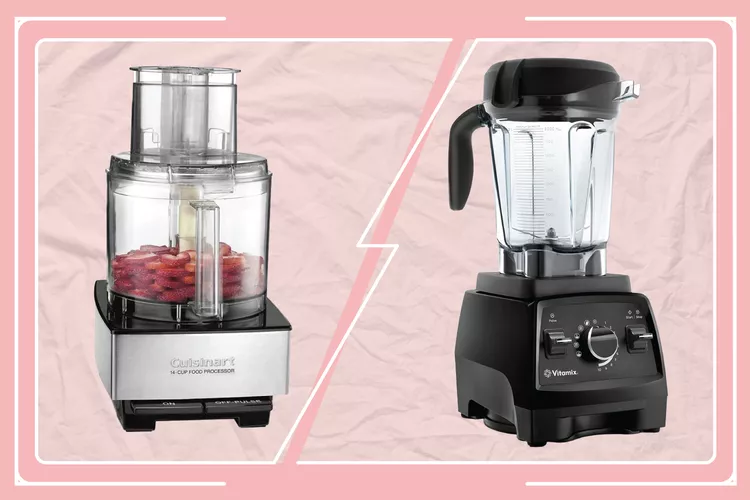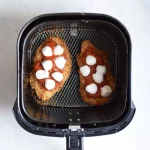On the surface, blenders and food processors are similar kitchen appliances: They use spinning blades to break food into smaller pieces. Both come in manual and electric versions, in a wide variety of sizes, designs, and power levels. But food processors and blenders have important differences that make one or the other better for different jobs.
Main Takeaways
- Smaller blades that spin faster
- Good for liquefying, pureeing, crushing ice
- Creates a vortex to mix ingredients thoroughly and evenly
- Needs lots of liquid to work
- Larger blades that spin slower
- Good for chopping, grating, slicing
- Multiple blades/attachments for different jobs
- Not good with thin liquids or ice
Can you use a blender as a food processor or a food processor in place of a blender? Sometimes; it depends on what you’re making. Which one should you buy? It depends on what you need it for and how much you plan to use it. (It might be worth owning both!) To help you choose between a food processor and a blender, keep scrolling for a rundown of how they perform head-to-head on lots of different common kitchen tasks.
Cuisinart Food Processor
:max_bytes(150000):strip_icc():format(webp)/Cuisinart-14-Cup-Food-Processor-86ea55257eb04fccadd45cf4c5ef93a6.jpg)
What It’s Best For: Chopping carrots, shredding cabbage, slicing potatoes, grating cheese, kneading dough, soup, hummus
If you’re going with a food processor, this is our top choice. In both Lab and home testing, this large-capacity processor was a workhorse, handling all the chopping, slicing, grating, pureeing, and kneading tasks we threw its way with ease. Both sets of testers called out its large food chute as a convenient feature, and its heavy-duty construction is designed to last for years and years. It’s fairly expensive, but nowhere near as expensive as some of the top-end models it outperformed.
For a more budget-friendly option, we recommend the Hamilton Beach 12-Cup Stack & Snap Food Processor.
Vitamix Professional Series 750 Blender
:max_bytes(150000):strip_icc():format(webp)/vitamix-professional-series-750-blender-professional-grade-64-oz-low-profile-container-black-self-cleaning-1c0726ec69a44fc090a1cb8e4b4ba7fa.jpg)
What It’s Best For: Smoothies, frozen cocktails, milkshakes, hollandaise, soup, hummus
If you go the blender route, this is the model we stand behind. We’re not going to lie: Vitamix blenders are very expensive, but their incredible performance and durability absolutely earn that bank-breaking price. This model’s 2,400 watts of power made it the number one choice in our head-to-head comparison of Vitamix blenders, and it excelled generally in both Lab and home tests, which included making a kale smoothie, homemade peanut butter, tomato sauce, rice flour, and whipped cream. (It’s able to further whip cream into butter; there’s a setting just for that.)
Our home tester was even able to get completely pulp-free celery juice from fresh stalks, which is an impressive achievement. The 750 has a lot of pre-programmed settings for different tasks, but it also allows you to adjust the speed however you like manually. Plus, its low-profile pitcher helps it fit inside or underneath cabinets more easily.
If you’re looking for a budget-friendly blender, we recommend the Ninja Nutri Pro Compact Personal Blender.
The Differences
Blenders have small blades that spin very fast. The sharp bits are only in contact with a small amount of food at once, but they really pulverize that food (or ice, in the case of blended drinks). This works best with mostly liquid contents, and the tall, narrow shape of a blender cup helps the spinning blades create a vortex that sucks material at the top down to be mixed in evenly. An immersion blender (aka stick blender) has the same small blade, but attaches it to the end of a water- and heat-proof post you can put directly into a pot of hot soup, bowl of cooked fruit, measuring cup of eggs, or basically anywhere else you need it.
It’s the exact opposite with food processors, which have large blades that spin more slowly. Because the blades are in contact with a lot of food at once, they’re able to chop whole fruits or veggies into evenly sized pieces with just a few pulses. Most food processors come with an assortment of extra blades and other attachments designed for slicing, grating, or even kneading dough.
The Tasks
Make a Smoothie
Winner: Blender
To crush juice, fresh or frozen fruit, and ice into a tasty smoothie that’s, well, smooth, a blender is the clearly better choice. Food processors tend to have trouble with watery mixtures as their slower blades just sort of push solid chunks around in the liquid instead of chopping or grinding effectively. If there’s enough liquid in the jar, a blender’s blades form a vortex that sucks in any stray solids and keeps your smoothie from being chewy. It is still possible to make a smooth smoothie using a food processor; make sure to puree any whole fruits or other solid ingredients as finely as possible before adding liquids.
:max_bytes(150000):strip_icc():format(webp)/Vitamix-test-VitaMixTurboBlend-2I6F2773.jpg-d4391cd2623c4bbd9d868f320b256ff6.jpg)
Make a Frozen Cocktail (or Milkshake)
Winner: Blender
They don’t call them blended drinks for nothing. The blender is the definite champ when it comes to crushing ice for a frozen margarita, banana daiquiri, piña colada, or similar refresher. Blenders are able to smash whole ice cubes into tiny-but-still-frozen bits, while also whipping in lots of air for a frothy drink. A food processor’s chopping blades tend to chip off bits of ice that melt before the rest of the cube can be broken up, resulting in a watery beverage. It’s the same situation with milkshakes: A food processor will melt more of the ice cream while doing less whipping than a blender.
Make Hollandaise
Winner: Blender
This one’s a close call, but the blender just barely takes the crown when it comes to incorporating butter or oil into an emulsified sauce, like hollandaise or homemade mayonnaise. Its whirling vortex ensures all the ingredients are constantly mixing together, and you can easily drizzle in the fat while the blender runs to avoid the sauce breaking. You can definitely make hollandaise or mayonnaise in a food processor, too, but you might need a larger volume of ingredients to fill up the bowl enough for the blades to effectively mix everything together.
Puree Soup
Winner: It’s a tie!
Turning a mix of liquid and cooked veggies—cucumber, pumpkin, potato, parsnip—into a smooth and delicious soup is right in the wheelhouse of both the blender and the food processor. Just dump in the ingredients and let it run until smooth. For a raw soup, like our vegan cream of broccoli, a blender is better able to break down the fibrous raw veggies—a raw soup is basically a savory smoothie, after all.
Here’s a good rule of thumb: If you can sip it with a straw, you want a blender. If you can stab it with a fork, you want a food processor.
Make Hummus
Winner: It’s a tie!
Blenders and food processors are both effective ways to make thick, spreadable dips and sauces, such as hummus, artichoke dip, or pesto. In either case, it’s important to stop the machine periodically and scrape down the sides to ensure all the ingredients are mixed in. A blender will make a very even-textured mixture, while a food processor can leave things a little more chunky if you don’t process them as long; it’s really up to personal preference which style you prefer.
Chop Carrots
Winner: Food processor
You could use a blender (a pretty powerful one) to make whole carrots into carrot juice, but it’s not really good for any texture in between. A food processor’s big blades, on the other hand, are made for cutting a bunch of vegetables into evenly sized pieces all at the same time. The longer you run the machine, the smaller the pieces get, so going from large dice to small dice to mince is just a matter of hitting the pulse button a few times.
:max_bytes(150000):strip_icc():format(webp)/Testing-Hamilton_Beach_StackSnap_17-RussellKilgore-688-036e58bb5e594bca88970711fc84b1bd.jpg)
Shred Cabbage
Winner: Food processor
Most food processors come with an adjustable slicing blade that’s the ultimate tool to shred cabbage for coleslaw or sauerkraut. Whether you like paper-thin slivers or thick, crunchy slices, a food processor gets you evenly shredded cabbage for an uniformly textured final dish.
Slice Potatoes
Winner: Food processor
Yes, shredding cabbage and slicing potatoes are essentially the same thing, and they use the same food processor attachment, but we’re highlighting the potato-slicing prowess of the food processor because it’s critical for great homemade potato chips. Whether you’re making air-fried potato chips, oven-baked potato chips, or traditional deep-fried potato chips, slices of even thickness are critical for even doneness. While just as effective as a mandoline, a food processor is faster and safer for the knuckles.
Grate Cheese
Winner: Food processor
Food processor owners often forget about the accessories most models include, so they don’t get the most out of theirs. In addition to a slicing wheel, there’s probably also a shredding/grating wheel that’s like a box grater on steroids. If you need a lot of mozzarella for a pizza party or a bevy of cheddar for baked potatoes or burgers (or shredded potatoes for hash browns), let your food processor do the work.
Knead Dough
Winner: Food processor
You can knead pizza dough or bread dough in a food processor, and all you need is the standard blade. Add all the dry ingredients, pulse to combine, add the wets, and keep pulsing until you get a fully kneaded dough ball. In theory, this will take less than a minute. (Some machines come with a special plastic kneading blade that’s more gentle on the dough, but the procedure is the same.) The food processor doesn’t give you the same level of control as a stand mixer, but it does a great job at kneading—certainly better than a blender.
Grind Coffee Beans
Winner: Neither!
If you plan to brew coffee at home using whole beans, you need a dedicated coffee grinder. Coffee beans are very small and very hard, and neither a blender nor a food processor is equipped to properly break them up into even pieces. Run for long enough, either machine could eventually reduce whole beans to powder, but that’s too fine to use in any brewing method without ending up with gritty coffee. A coffee grinder has a small cup and blades specialized for cracking coffee beans apart into even bits. (The same rule applies to hard spices like peppercorns, cloves, or cinnamon; a coffee grinder doubles as a spice grinder, but a blender or food processor does not.)
Should you buy a blender or food processor?
Well, which of the above items will you be making frequently? If you can’t start the morning without a smoothie for breakfast, a blender is the best choice. If you’re always chopping veggies and slicing up chips, a food processor is what you need. A mini food processor is a good option for those chopping herbs and making sauces. If you’re a serious home cook who makes all kinds of recipes, you might want both.
If you have both, should you use a blender or food processor? If it doesn’t fall into the categories above, here’s a good rule of thumb: If you can sip it with a straw, you want a blender. If you can stab it with a fork, you want a food processor. If you use a spoon, either one will probably work.



